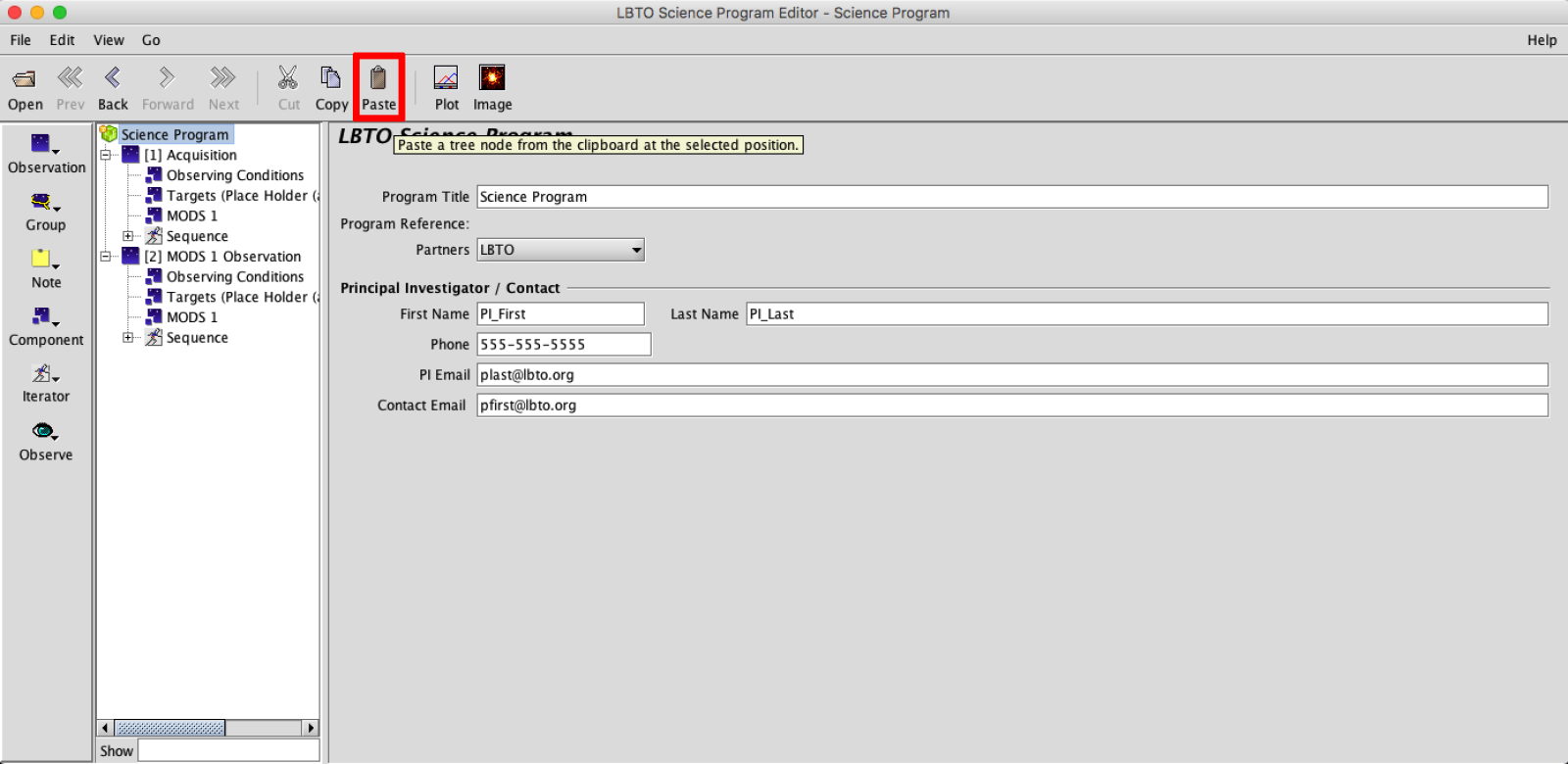2: Long-Slit Example
Example 2: Setting up Long-Slit Observations
Highlight the Acquisition and Science Template for the desired type of observation and then click COPY in the Main Toolbar.
Back in the *empty* Science Program PASTE the observations by hitting PASTE in the Main Toolbar
Tailor the Template with you Observation details following the tree of the Observation in the Template:
- Observation Element: For both the Acquisition and Science Observations, change the Observation Name from the generic template name to something descriptive. Make sure to distinguish between the Acquisition and Science portions of the observations. This can help observers easily identify observations in the OT Science Program if multiple observations are provided.

- Observing Condition Element: Complete the information in the Observation Conditions Element by selecting the nodes that roughly align with what was requested in your TAC proposal. These conditions are not guaranteed conditions and are not passed to the script in any way. Pro Tip 2: Since Observing conditions information is not passed along in the Observing Scripts, it is important to not only pass along your complete scripts but this complete OT Program as well to LBTO and the Partner Coordinator. Details for exporting the OT are available here.
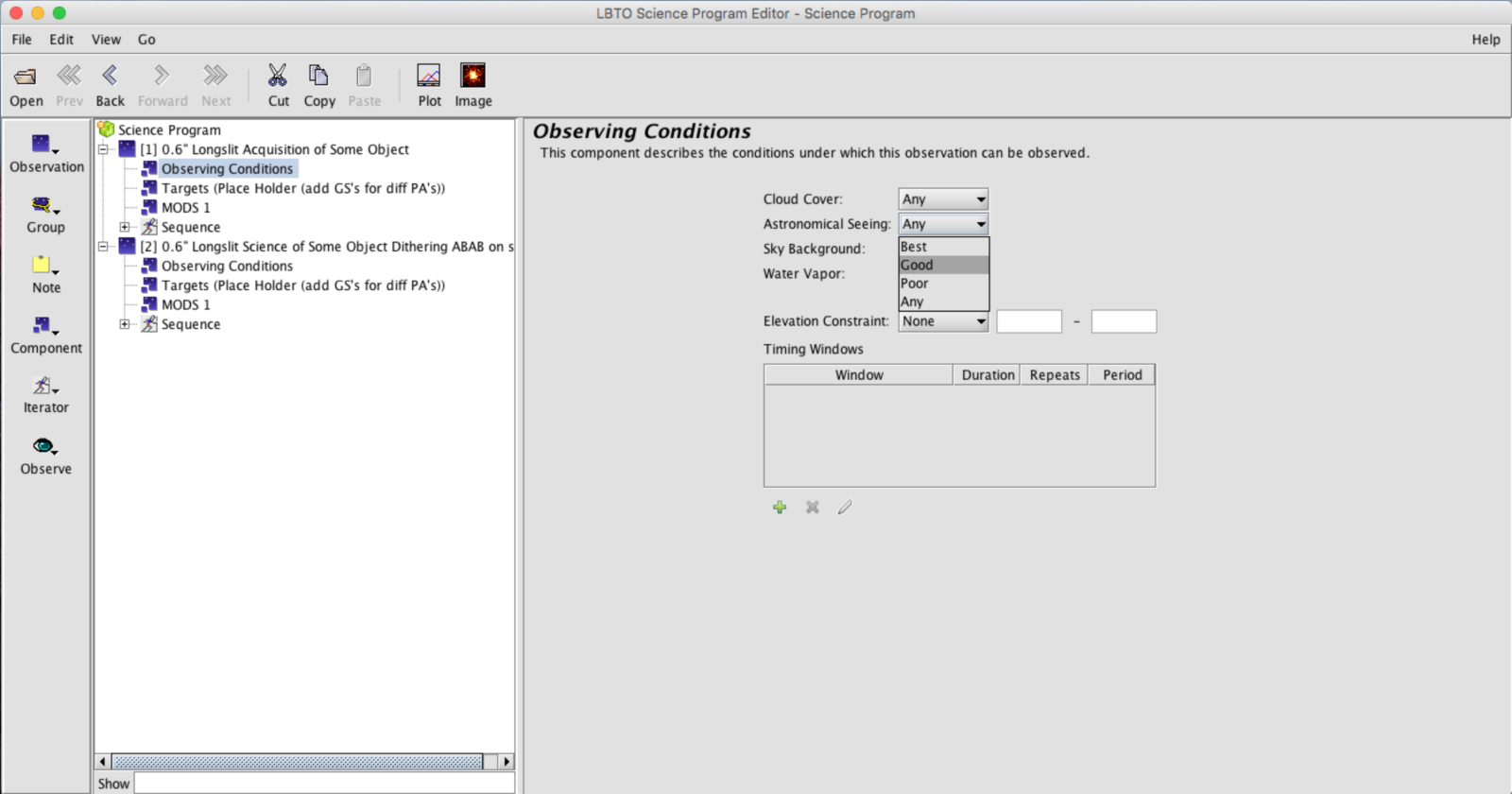 Copy and paste the Observing Conditions Element between the Acquisition and Science Observations for consistency. To do this, with the Observing Conditions Element selected in the Acquisition Observation select COPY in the Main Toolbar. Select the Observation Element of the complimentary Science MODS observation and select PASTE from the Main Toolbar.
Copy and paste the Observing Conditions Element between the Acquisition and Science Observations for consistency. To do this, with the Observing Conditions Element selected in the Acquisition Observation select COPY in the Main Toolbar. Select the Observation Element of the complimentary Science MODS observation and select PASTE from the Main Toolbar. - Target Element: Enter Target. Either enter a valid SIMBAD Target Name and hit enter. If recognized, the coordinate field, magnitudes, and proper motion will populate. Or manually type in your Target Name, Coordinates, Brightnesses, and Proper Motion. In this Element you can adjust the Position Angle of the observation (circled in green below).
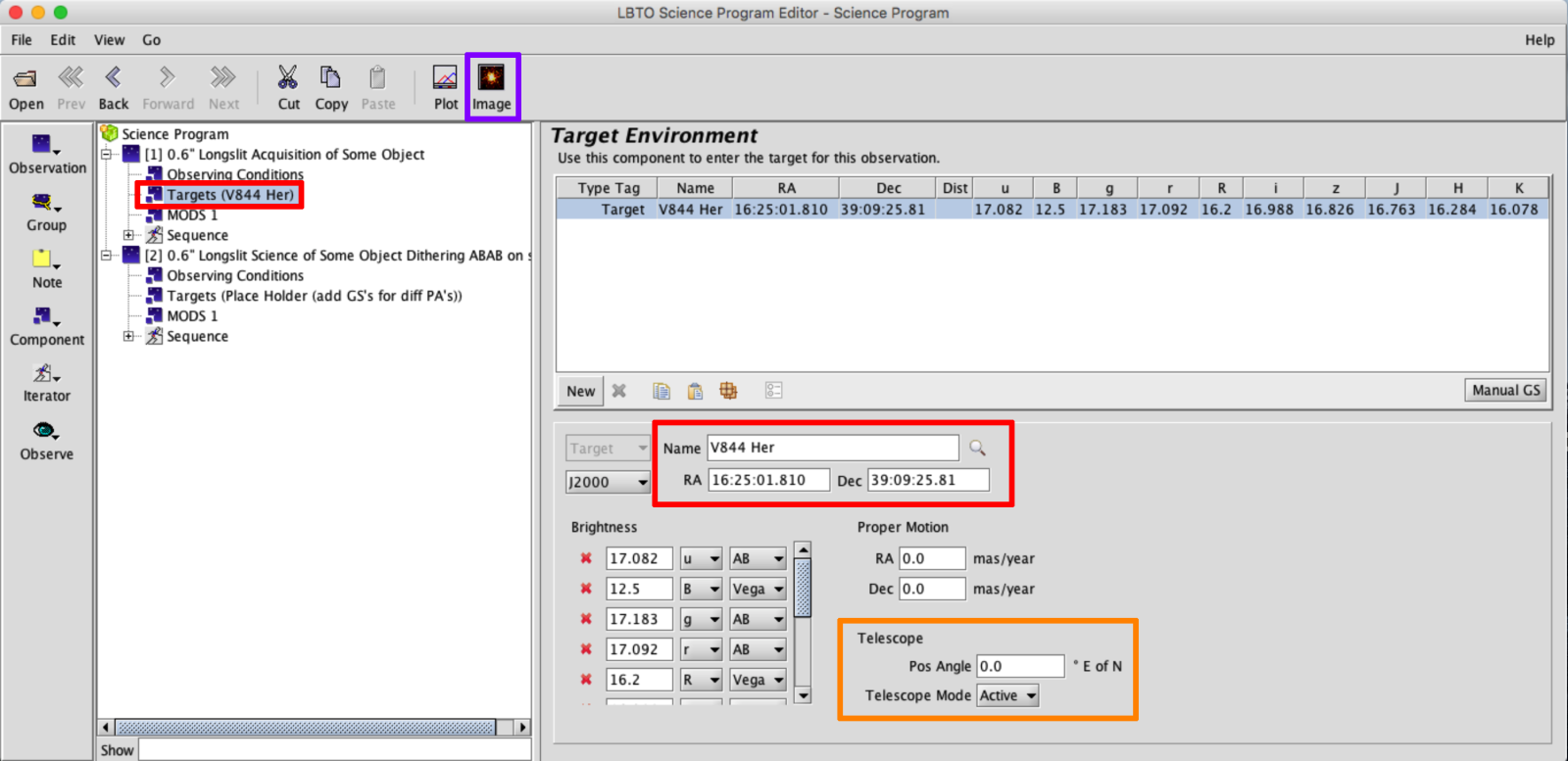
Click on the Image button in the Main Toolbar to bring up the Position Editor. The Position Editor will allow you to visualize the Target, as well as the the Guide Field and Mask if one is in place. This can be used to select a guide star. Any Offset pattern will also be overlaid. To bring up a default Catalog Image in the Position Editor, click on Image in the Toolbar in the Position Editor.
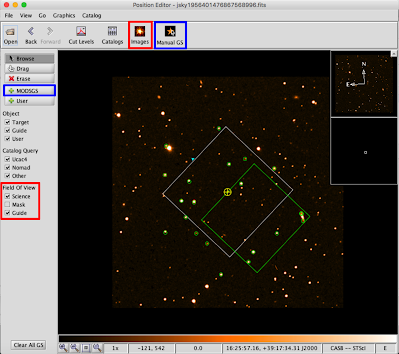 Select the desired elements in Field of View area to see overlays of the Guide Prove FOV, Science FOV and Masks (these often will come up by default).
Select the desired elements in Field of View area to see overlays of the Guide Prove FOV, Science FOV and Masks (these often will come up by default).
- Obtain a Guide Star. This can be done 2 ways, each described below. MODS does not have an Atmospheric Dispersion Corrector, so long-slit observations should be chosen with slit orientation that minimizes slit losses due to differential atmospheric refraction, especially at blue wavelengths. One can select multiple guide stars for a variety of PA’s so that depending on time of observation the observer can easily generate a script observing with a median PA for the observation time.
- With Target Element: Select New in the Target Element. In the drop down menu, select MODSGS to create a new guide star element in the Target Environment. You will need to manually enter a valid SIMBAD designation or the RA DEC for the Guide star. This is a useful option is the guide star is previously known.
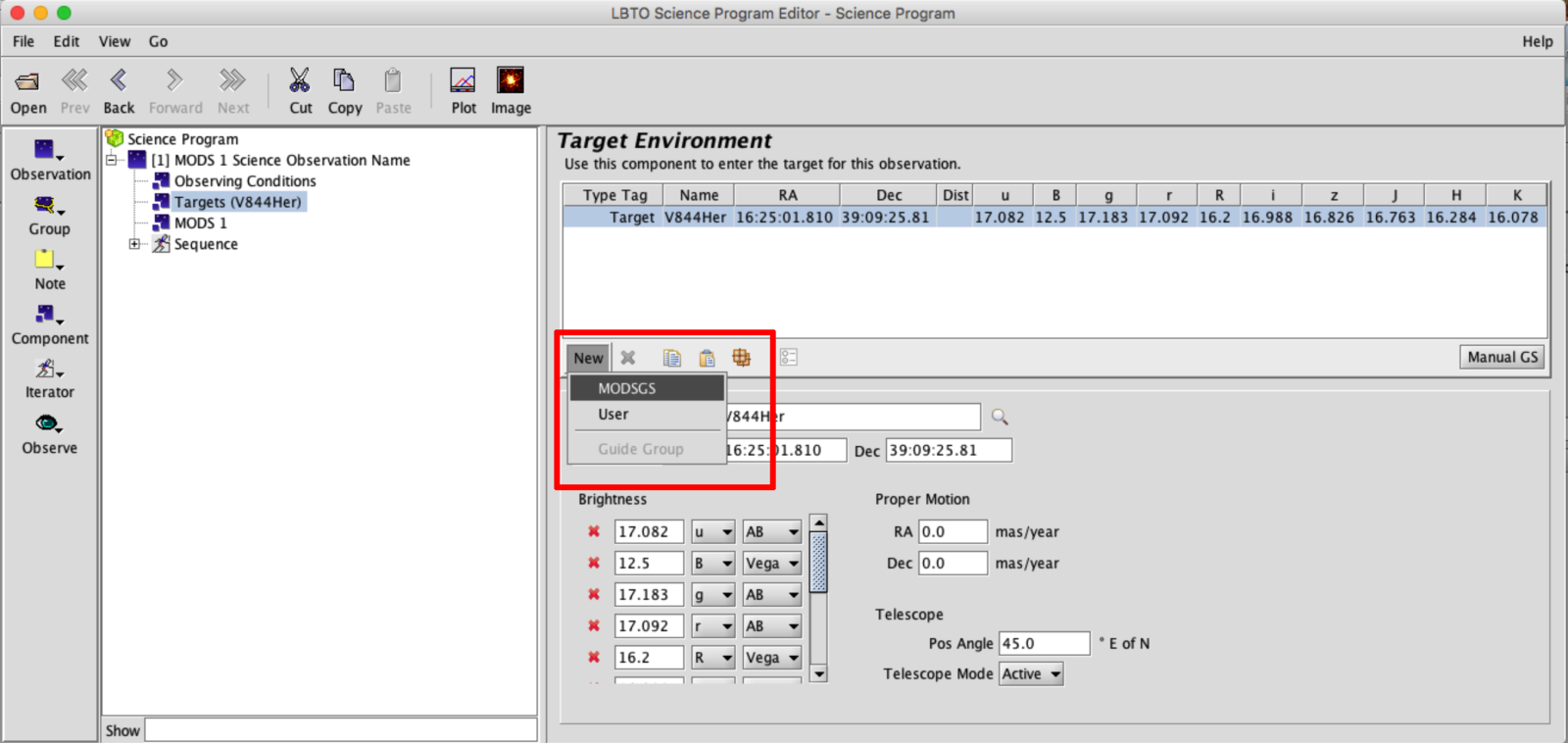
- With Position Editor: Click the “Manual GS” button on the right of the Target Element. This will bring up the Position Element with a popup. In the popup you can select either the NOMAD or UCAC4 catalog for your Guide Star options.

Once you select ok, the catalog will be queried and the catalog stars will be highlighted in the Position Editor (green for NOMAD and turquoise for UCAC4). Select the +MODSGS option on the left Toolbar then click on guide stars that fall within your Guide Probe FOV (overlay outline green). You will see an overlay of the actual probe footprint appear over the selected guide stars.

This will allow you to see if the probe will vignette. The selected stars will populate in the Target Element. Enter different PA’s in the Target Element to see different orientations of the MODS and and GUIDE FOV.

Copy and paste the Target Element between the Acquisition and Science Observations for consistency. To do this, with the Target Element selected in the Acquisition Observation select COPY in the Main Toolbar. Select the Observation Element of the complimentary Science MODS observation and select PASTE from the Main Toolbar.
- With Target Element: Select New in the Target Element. In the drop down menu, select MODSGS to create a new guide star element in the Target Environment. You will need to manually enter a valid SIMBAD designation or the RA DEC for the Guide star. This is a useful option is the guide star is previously known.
- MODS Instrument Element: This element will define the initial configuration of the instrument. Set the Configuration first: Dual Grating, Dual Prism, Red Grating, Red Prism, Blue Grating, or Blue Prism.
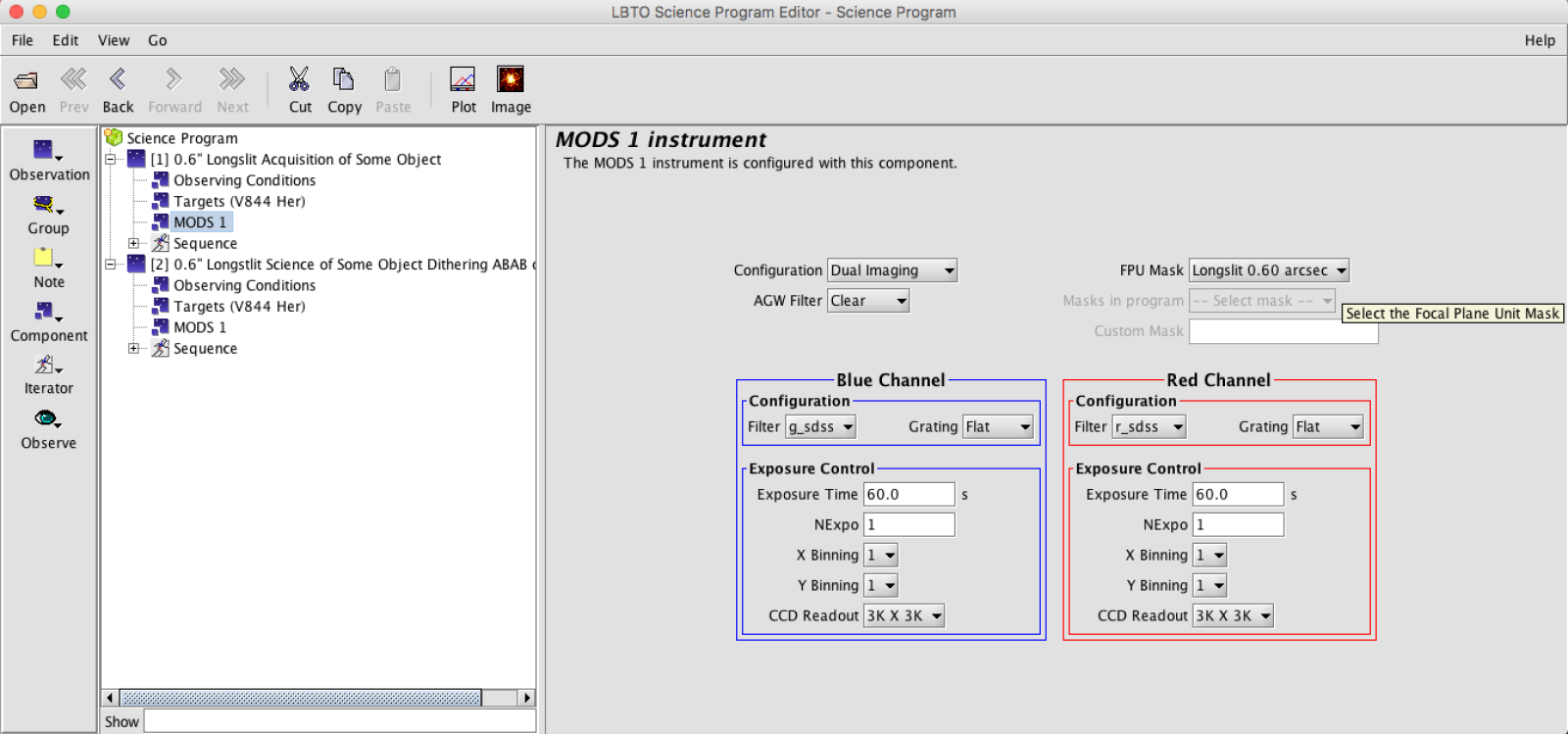 The Disperser, CCD Readout, and order sorting filters will auto populate (for example, any grating observation the CCD Readout is set to 8Kx3K, and for prism the CCD Readout is 4Kx3K). Then set the Long-Slit Mask from the FPU Mask dropdown. If using a custom mask, follow the Multi-Slit Mask Instructions.If observing a particularly bright guide star, one may wish to insert a filter into the AGW. In the Camera element(s) exposure time, number of exposures, and binning for the initial instrument configuration filling in the fields and nodes. These fields can be adjusted for exposures beyond the first exposure in the sequence tab. Set this Element in both the Acquisition and Science Observation. Make sure that the mask used in the Acquisition is the same as that used in the Science Observation.
The Disperser, CCD Readout, and order sorting filters will auto populate (for example, any grating observation the CCD Readout is set to 8Kx3K, and for prism the CCD Readout is 4Kx3K). Then set the Long-Slit Mask from the FPU Mask dropdown. If using a custom mask, follow the Multi-Slit Mask Instructions.If observing a particularly bright guide star, one may wish to insert a filter into the AGW. In the Camera element(s) exposure time, number of exposures, and binning for the initial instrument configuration filling in the fields and nodes. These fields can be adjusted for exposures beyond the first exposure in the sequence tab. Set this Element in both the Acquisition and Science Observation. Make sure that the mask used in the Acquisition is the same as that used in the Science Observation. - Sequence Element:
- Acquisition Sequence: The MODS long-slit Acquisition Sequence is composed of 3 components: Slit Image, Source Image, and lastly a confirmation Slit + Source Image. The Sequence is comprised of a MODS Sequence Iterator and Observe Type. Select the MODS Sequence Iterator. Within this Element you will see the 3 exposures for the Slit Image, Source Image, and lastly a confirmation Slit + Source Image.
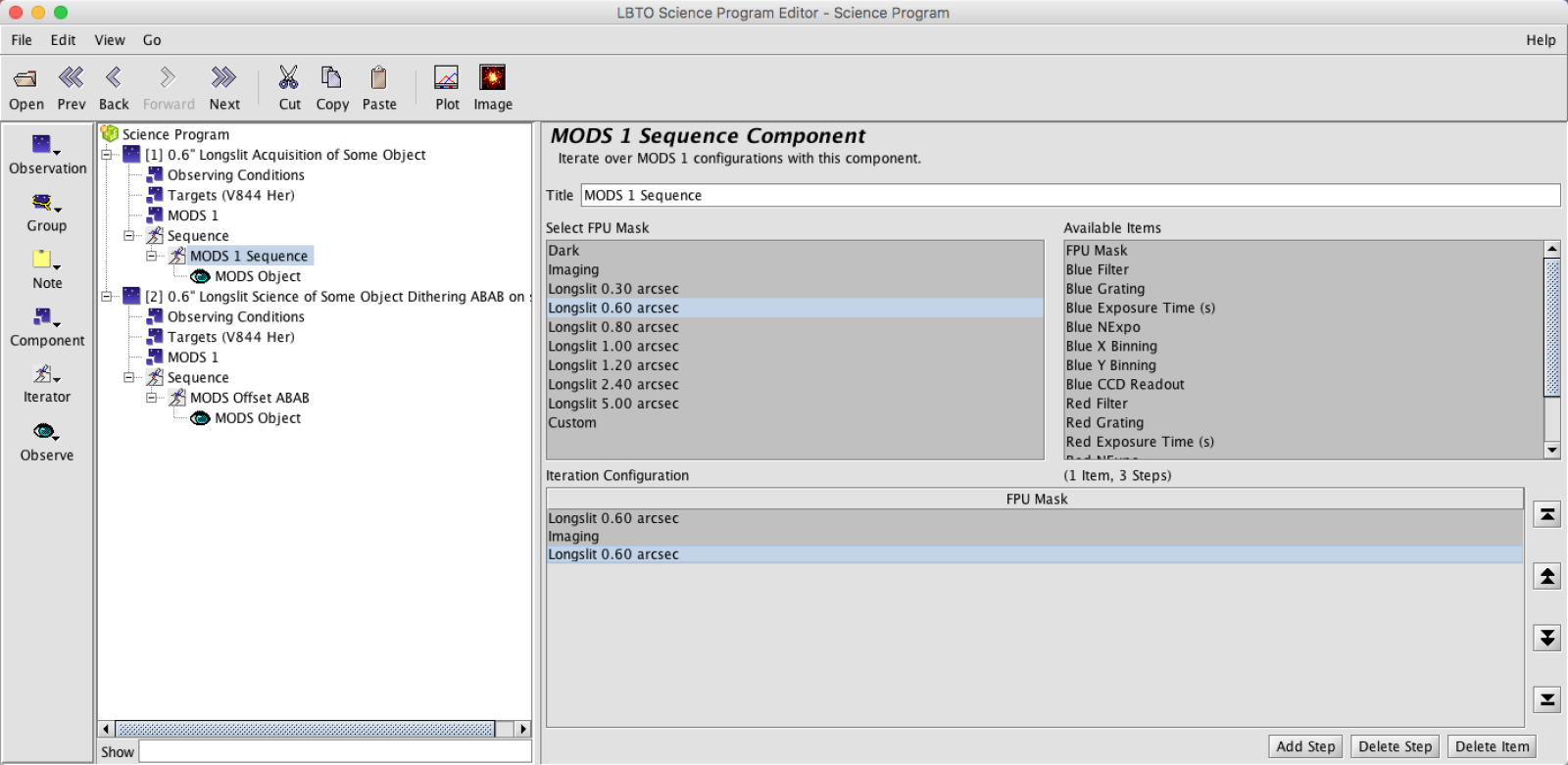
For good housekeeping, change the mask for the Slit + Source Image to match the mask you set in the MODS Instrument Element (first element in the sequence). What ever mask is set at the top of the script (set in the Instrument Element and shown as the Slit image mask) will be set for the entire script, but it is best to be consistent regardless. - Science Sequence: The MODS long-slit sequence is composed of 1 to 2 iterators: possibly an MODS Offset Iterator, and Observe Type. With MODS, Offsets are not always performed so the presence of the Offset Iterator will depend on the template selected and desired science. For the “MODS# Longslit Dithering Along Slit Templates”, there will be an offset iterator nested in the Sequence.
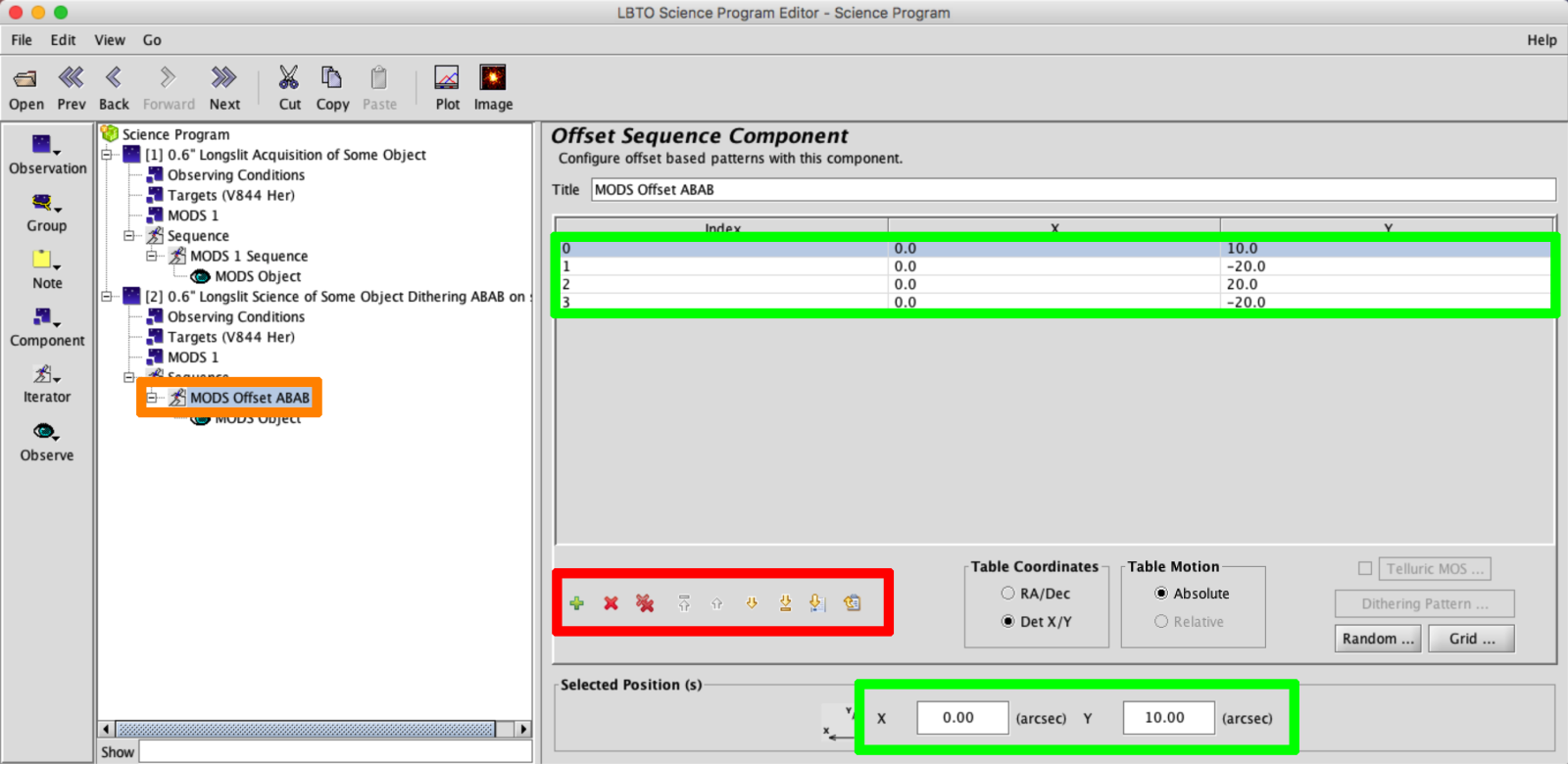
Use the Iterator Action Items (in red box above) to add, remove, or move offset positions. Offsets can be adjusted by selecting the desired offset in the table, then entering the new value in the Selected Position(s) field at the bottom (green).
- Acquisition Sequence: The MODS long-slit Acquisition Sequence is composed of 3 components: Slit Image, Source Image, and lastly a confirmation Slit + Source Image. The Sequence is comprised of a MODS Sequence Iterator and Observe Type. Select the MODS Sequence Iterator. Within this Element you will see the 3 exposures for the Slit Image, Source Image, and lastly a confirmation Slit + Source Image.
Generate both the acquisition and science observation scripts. Script generation is discussed here


